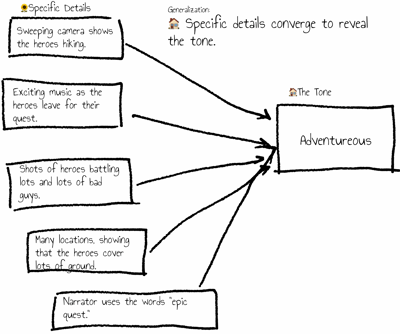How do we teach students to recognize the tone of a piece of writing? I struggled with explaining this abstract concept before landing on the perfect tool to help express the meaning of tone: movie previews or trailers.
1. Introduce Tone
Since tone is very abstract compared to the plot, characters, or setting, let’s nail down the meaning in a way students can comprehend. To do so, start with what your students already know:
- Ask whether previews accurately represent the plot of the movies they advertise.
- Ask whether previews present an accurate representation of the characters.
- In both cases, the answer should be “no” because this is not the purpose of movie previews.
- Ask what, then, do previews show us about a movie? What do they accurately represent?
- Possible answers: the “feeling” of the movie, the genre, or just “what it’s like.” What students are dancing around here is tone.
- Create a clear definition of tone with your students to refer to later.
At this point, introduce your students to the generalization:
“Specific details converge to create tone.”
Yes, we’re starting this lesson with a 🏛️ Big Idea and then moving towards concrete 🌻 Details. That makes this a deductive lesson, which you can learn more about here.
2. Practice With Movie Previews
Watch a pair of previews at this point. They should have very different tones. I showed Lord of the Rings and Wall-E. (Please preview the previews. Wall-E‘s trailer had a shot of a bra that I, uh, could have done without 🙄)
The purpose in watching these is to identify the tone of each preview. Is it comedic, exciting, frightening, intense, romantic? Try to push students to use exact terms to describe the tone.
Now return to the generalization: “Specific details converge to create tone.” Ask students what specific details in each preview contributed to its tone. Possible answers include:
- Musical cues
- The color scheme
- Certain words spoken by characters or the narrator
- Camera movement
- Characters’ movements
- Facial expressions
Furiously jot down all of these specific examples. Build a graphic organizer that visually supports the generalization. If you’re a Thinking Maps person, the left-half of a multi-flow map works great for this.

If you want to, show a third preview and, this time, allow students to go through the exercise in pairs or trios (or alone!).
At this point, you should feel confident that your students understand how to show the “specific details converge to create tone.” If not, practice more, model another example, or try letting a student explain their thinking.
3. Practice With Poetry
Now you can transition to the true purpose: identifying the literary elements that contribute to a story or poem’s tone.
Pick two poems with vastly different tones for your students to read. I used Poe’s The Raven and Shakespeare’s Sonnet 18 with my 6th graders. (Note: I’m sneaking in some classics here. Read more about this differentiation technique here.
Read through these poems (probably more than once). Discuss. Clarify. Once students are familiar with the poems, ask them to identify the poems’ tones. Refer again to the generalization. Just as before, they must also identify the specific elements that create the tone. Possible details include:
- Dialog
- Word choice
- Figurative Language
- Line length
- Punctuation
- Rhythm
As before, students should build graphic organizers to show how an author creates tone using specific examples.
4. Culminating Activities
After teaching students to analyze the details that converge to create tone, my students produce a compare-contrast essay covering the tones of two poems or stories.
Students also eventually created their own poem with the goal of establishing a clear tone. They presented their poem to the class, first introducing the tone and explaining the specific details that created their tone.
Choose the type of poem you are most comfortable with, I have used sonnets, free verse, and even haiku. By beginning with an accessible example and a generalization to attach meaning to, your students will have an easier time identifying the elements that create a poem’s tone.
